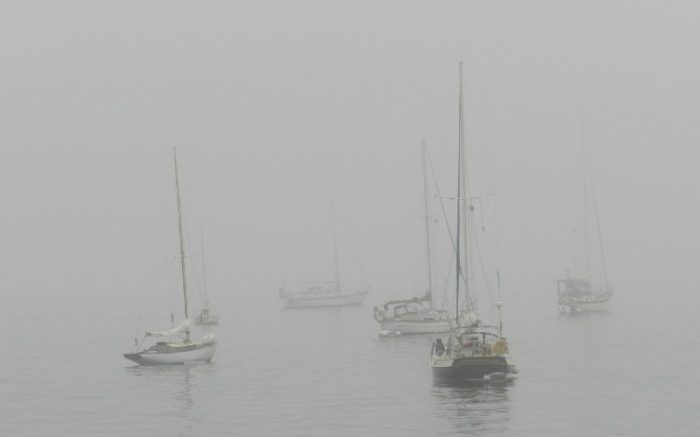How to Calculate the Distance to the Horizon
Calculating the distance to the horizon takes a bit of clever math. Not necessarily complicated, but not intuitive either. Consider what you’re trying to figure out, after all. You’re looking out from your boat across the water to the horizon line. And though it looks like a flat run from you to the edge of the planet, you know that’s not true. The water you’re looking at is actually curving into the distance with the shape of the Earth. It’s a little mind bending when you think about it.
So, how do we determine the distance from where we’re standing to the horizon? If you have an app on your phone or even an old almanac it may not be so hard. But let’s say you don’t have it. Well, the first thing you need to know is where you’re standing. Not all of us stand the same, right? And you’ll be using the height of your eyes as a guide, since that’s the point you’re measuring from. The calculation will therefore be different for a person standing on the deck of a fishing trawler compared to someone sitting in a kayak.
The one piece of information you need going into this is the radius of the Earth itself. For our calculation we’re going to use 3,958.8 miles.
The Formula
The full method of achieving this formula is needlessly complicated but know that, when using the proper radius of the Earth, you can get a simple formula for determining distance to horizon. That formula is:
1.22459√h
That means 1.22459 (a number we derive from knowing the radius of the earth and using the Pythagorean Theorem) times the square root (√) of your eye height (h). This calculation uses a fairly precise measurement for the earth’s radius and will give you very accurate numbers. If you’re curious about how the entire equation is developed, you can check it out on this site here.
Many sites that offer up similar calculations tend to round their numbers up. This is fine, of course, the difference between 2.8 miles and 3 miles when you’re eyeballing the horizon isn’t all that significant. But for the purposes of accuracy we’re giving you some solid, if longer, numbers.
So let’s say you’re sitting in your boat and your eyes are 3 feet above the surface of the water. The formula becomes:
1.22459√3
The square root of three is 1.73205080757. So now the formula becomes:
1.22459 x 1.73205080757
So the distance to horizon, based on this, is 2.12105209844 miles.
If you’re standing up and you’re about 6 feet tall, let’s say your eyes are sitting at about 5.5 feet. That means;
1.22459√5.5
or
1.22459 X 2.34520787991
That equals 2.87191811766 or nearly 3 miles off.
Things to Remember
Calculating square roots in your head isn’t always the easiest thing to do. That’s why having your phone handy for the calculations is ideal. And, as you can see, the distance increases the greater the height. That means standing on the deck of a massive cruise liner will offer you a distance to horizon far greater than what you’ll get sitting in a canoe.
One thing you’ll want to remember here is converting to decimals. This is important for height. In our second example we used 5.5 feet. That works out to 5’6”. But if your eye line is higher, say 5’9” you’ll need to convert to decimal. So it’s not 5.9 feet, it’s 5.75 feet.
Calculation Errors
Our previous distance to horizon calculation involved a similar equation however the number used was 1.17 rather than 1.22459. Some folks asked where that number came from. We looked into it and, because this is such a prevalent issue, we’ll pass it on to you.
1.17 miles comes from the USCG Light List. This list, published annually by the Coast Guard, details all lighthouses, sound signals, beacons, buoys and other aids to navigation in a Coast Guard area. At the beginning of these lists you will find general information. In that general information you’ll find a calculation to determine the distance a person is able to see an object on the horizon. Their calculation is 1.17 X the square root of your eye height.
So there are two issues with this equation.
1 – What does 1.17 refer to? There is no indication from what source that number was derived. In our new calculation we show you how that number is determined by way of the radius of the Earth itself. The 1.17 is unknown.
2 – Is this actually a calculation to the horizon? The equation, as written, seems to indicate that it will determine how far you can see something, not necessarily where the horizon is. Those two may be and likely often are the same, but not always. However, without knowing how anyone came up with that 1.17 number, it’s a moot point.
So, if you see a calculation anywhere that offers up that number, take it with a grain of salt. The calculation will not offer a mathematically correct way to determine the distance to the horizon from your current point of view.
What About Maximum Visibility?
If you watch the weather report on TV, you may hear the local weather person mention maximum visibility. On a foggy day it may be very minimal, less than a quarter of a mile. On a clear day they may say upwards of 10 miles. But how can that be if the distance to horizon when you’re standing on shore may be less than 3 miles?
The thing you need to remember here is that maximum visibility is not about calculating where the horizon is. Instead, it refers to the ability to see and identify a prominent dark object against the sky at the horizon during the day. This is all related to the opacity of the atmosphere. So if it’s a hazy day, a smoggy day, or a rainy day, the visibility will decrease. The horizon is irrelevant in this case.
A Note of Thanks
Special thank you to Boatsafe visitor Robert Gillies who, among a couple of others, noticed our previous calculations were not entirely correct and pointed us in the direction of some superior math. Math is not always everyone’s strong suit but it’s nice to know how to use it when and where you need it! Once we were on the right track we discovered many sites were using that same calculation. And since it was derived from the United States Coast Guard it seemed perfectly legit. But now we know better!
Categories: nauticalknowhow
















18 Comments
John Wells on February 24, 2020
Where does the 1.17 come from?
Dan Frei on January 8, 2022
I do not know the significance of 1.17 but I know it is approximately 7/6, in case that might any significance.
W Clarke on May 26, 2022
DH = 1.169 * sqrt(h) is correct for how far you can see (in nautical miles). It accounts for refraction. The Coast Guard Light List is used for navigation; when you can see the light is important (not the actual distance). So, their use of this equation is correct. Look up the book “Bowditch”. You can find the PDF online. Table 12 is the “Distance to Horizon” table. The chapter “Explanation of Navigation Tables” explains the math for this and all the other tables.
ojizarco on May 12, 2023
Just checked my copy of “Bowditch” The US Navy and Coast Guard have been at this for over two hundred years.
Pub No. 9, American Practical Navigator,Bowditch, Vol. 1, 1984 Edition
Defense Mapping Agency Hydrographic/Topographic Center
Appendix T, page 1299, distance in Nautical miles=1.17(square root of height in feet)
https://msi.nga.mil/api/publications/download?key=16693975/SFH00000/Bowditch_Vol_2_LoRes.pdf&type=view
See page 125
Somerset on May 14, 2020
The formula for distance from an object the other side of the horizon is totally in correct. Buildings of different heights would have a horizon that overlapped yours so you would be double counting
Tyler on February 21, 2022
This is not distance at which something is visible, but distance to the horizon. If you’re looking for something “over the hill” you have to add its distance to its horizon as well.
t zevo on August 16, 2020
Why does the national weather service state (max) visibility at 10.00 miles?
Are they figuring that by some formula which “given” is eye level height higher than standard 6 ft. tall person?
Craig on January 27, 2021
On a clear day you can see St Kitts from St. Martin, but often the amount of water vapor will limit the distance and the light reflected off the vapor is greater than the light reflected off the island; the reason you can’t see stars in the daytime.
Robert Gillies on August 23, 2020
This formula is more accurate. Verified with Autocad on model earth with 3,958.8 mile radius.
Formula
DH =1.22459√h
where DH is distance in statute miles.
h is height in decimal feet. eg 5′-8″ is 5.677
https://sites.math.washington.edu/~conroy/m120-general/horizon.pdf
John Wells on April 4, 2021
Robert Gillis is correct.
If you convert his coefficient to Nautical Miles, it is 1.06, not 1.17.
Keith on December 31, 2021
I agree with John Wells, the coefficient for nautical miles is 1.06. Simple trig proves this. However, the Geographic Range Table near the front of every volume of the USCG Light List is consistent with the use of 1.17 instead of 1.06 (though the table makes no note of how it was derived).
Andrew Cumming on March 20, 2022
Construct a right triangle with run r (diameter of earth), rise d (distance to horizon) and hypotenuse r+a (a<<r is height of observer). Pythagoras says r^2+d^2=(r+a)^2. Expand, divine by r^2, throw away higher order terms of a/r and get
d=sqrt(2ar). Sub r=3438 nm and 1 nm=6076 ft and voila:
d (in naut miles) = 1.06 sqrt(a in feet). No idea where the 1.17 came from. It is totally incorrect.
Ronan Mandra on December 29, 2023
Consider atmospheric refraction
koiphish on May 19, 2022
I think it is important to first look at the error in real life measurements. Just the variance in the earths radius is about +/- 5 miles or about 0.5% error. Then a small wave of just 2ft gives you about another 10% loss of horizon distance for a kayak or dingy. That wave error would be based on how your vessel reacts to it … as in riding the top of it on a kayak or maybe averaging to 1/2 the wave on a vessel longer than the period of that wave. Then there is the object in the horizon, which also reacts to the wave based on its size and the wave height/period if the horizon is on the water. You might only see a kayak in 3ft waves (not just the persons head/body) for less than 10% of a 10 second wave period.
How many people look at one spot for 10 seconds solid when scanning a horizon?
Getting error down to less than 10% would be rare in most sea conditions, so 2 significant digits would be good here! This also means 6′ 6″ can just be 6.6ft!
What is much more important to observe is the ratio of you or your object height to the wave height. For example you can not really see the beach and rocks when you are 3ft high in a kayak/dingy looking for a place to break thru the surf 6ft high!
It is more useful to just know 2 – 10 miles (Kayak to top of 60ft mast)… but much less if wave height is near observer or object height. Also that you will not see a small vessel in waves unless you scan the horizon in a time about 1-2 sec less than the period of the waves for at least 10 times on that portion of horizon scanned. Another good search tip is that 100 views at the same spot might be needed over 15min for a random larger wave to lift object or observer above typical “significant wave height”. Worst case scenario is when both observer and object are in kayak/dingy with more than 3 foot wind wave.
So yes, this horizon calculation might work if you are on the equator in the tropics with no wind/wave or tide. Another important feature of this equation (square-root) shows that the height is less and less important as you get more height. Another way to say this is that the 2 mile view from a kayak is not really proportional to the 12 mile view off a 100ft tall cruse ship/mast! We expect to see 33x further … but can only see 6x further. Most sailing involves wind and many types of waves like swells, wind wave(aka local waves) and “significant wave height” all with variable wind direction/speed.
This equation seems much more useful to determine the distance of your water horizon from a certain elevation on land above sea level.
6ft is 3 mile horizon
10ft is 4 mile horizon
33ft is 7 mile horizon(short light house)
100ft is 12 mile horizon (average light house)
1000ft is 40 mile horizon
5000ft is only 86 miles horizon assuming good visibility!
30,000ft is 200 mile horizon
80,000ft is 350 mile horizon (military jet ceiling)
340 miles is 1650 mile horizon (3300miles total) (Starlink Sat low orbit shell #1)
NOTE: equation not working with large elevation values >40 miles up.
340 mile vs 22,000 mile GEO-stationary altitude is about 30mSec vs 600mSec RF Latency.
Stephen J Gale on July 1, 2022
A Lymington lobster fisherman once told me how given ideal conditions, when midway between St Catherine’s on the IOW & Cap Le Hague or Barfleur one can see both lighthouse beams if not the actual lighthouses . Given that I measure this to be approx 59 land miles and he was on the deck of a small boat so not having a great vantage , was he pulling my leg ? I also read a chaps’ claim how also given perfect conditions there’s a spot high up near Ventnor where the Barfleur lighthouse beam is visible but given he’s 600 ft above the sea that’s perhaps a fact. God knows why I’m fascinated by this but there it is. Any info or personal experience of such sightings would be interesting to hear.
Bruce Langford on November 19, 2023
I’ve heard of other sea-faring people who have seen a lighthouse for more than 50+ land miles. I also heard the other day of the fact that one can see Mount Canigou (2,874m) in the Pyrenees in France from Allauch (320m above sea level, near the town of Marseille, on a clear day in summer. The distance between the two points is approximately 263kms. With globalist theories, the top of Mount Canigou should be unseen, at least 300 metres below the horizon. With all the clever modelling that global theories use, they can’t explain these occurences except to talk about some effect of ‘refraction.’ Does it work like that at night too?
Kevin B on October 15, 2022
It is VERY possible that the 1.17 was based on a similar height about water, not the water line itself. Maybe 12″? Mayre 6″? I’m not running the math right now, but they very likely assumed some height of “object” and NOT the water surface.
Hutch on June 6, 2023
I believe (not sure! I can’t find any explanation!) that the 1.17 takes into account BOTH the curvature of the earth and average refraction. I also recall that Bowditch says something along the lines of this being a rough estimate and that it’s not valid for longer distances. I don’t have my copy handy, but I remember seeing that statement.